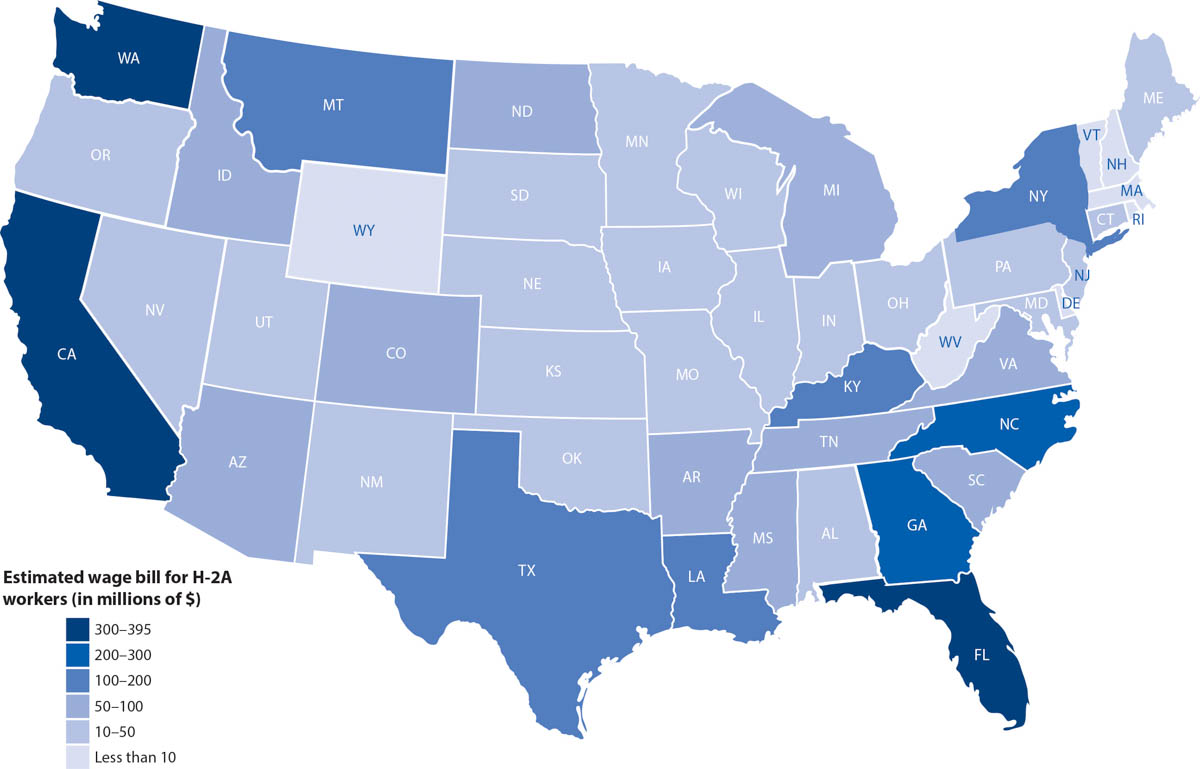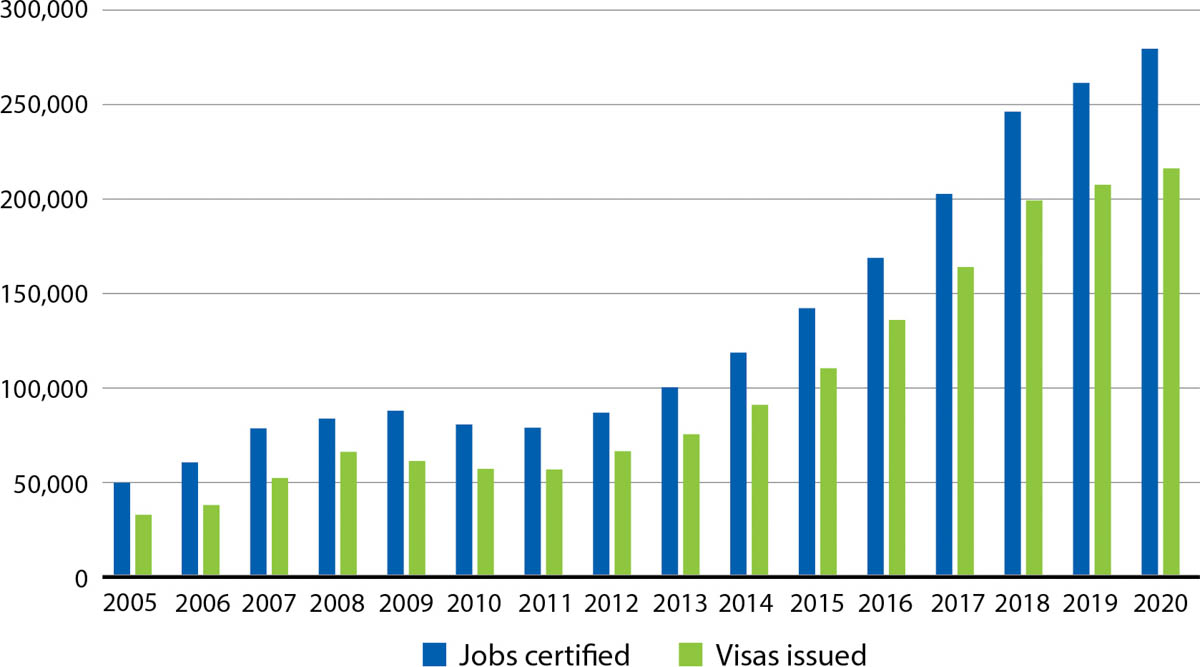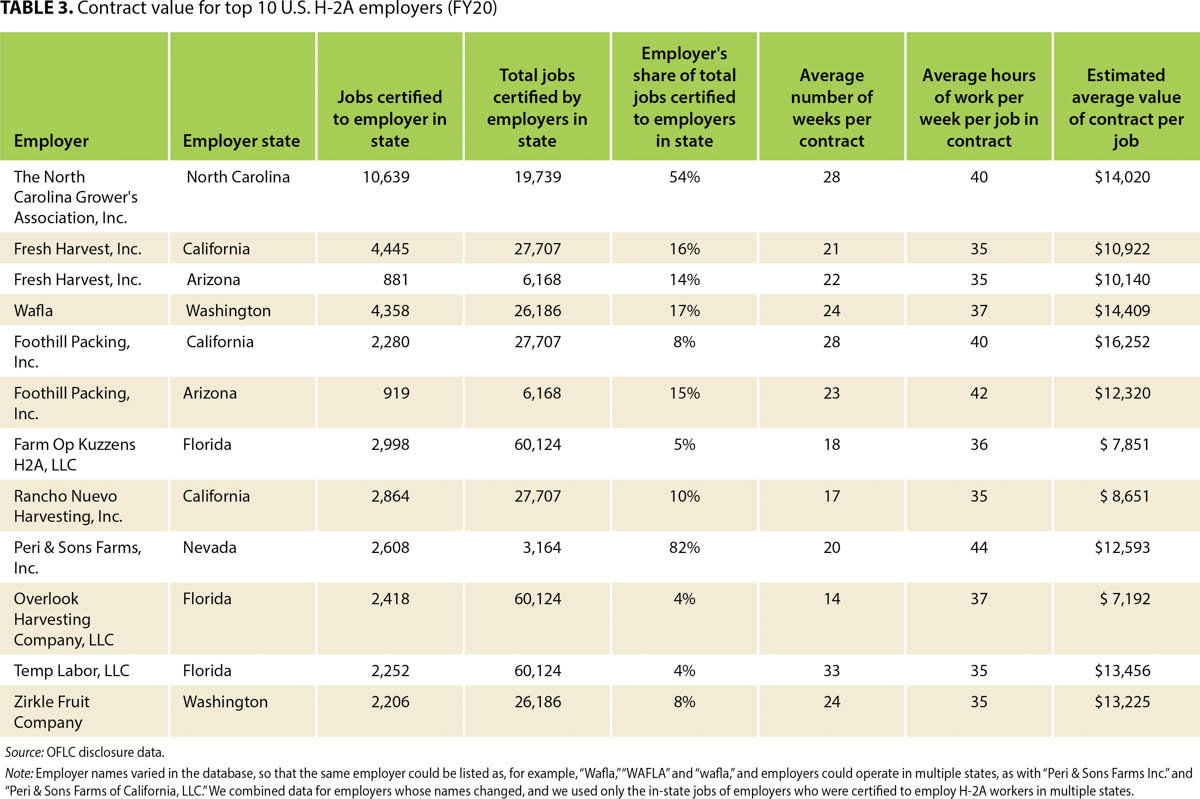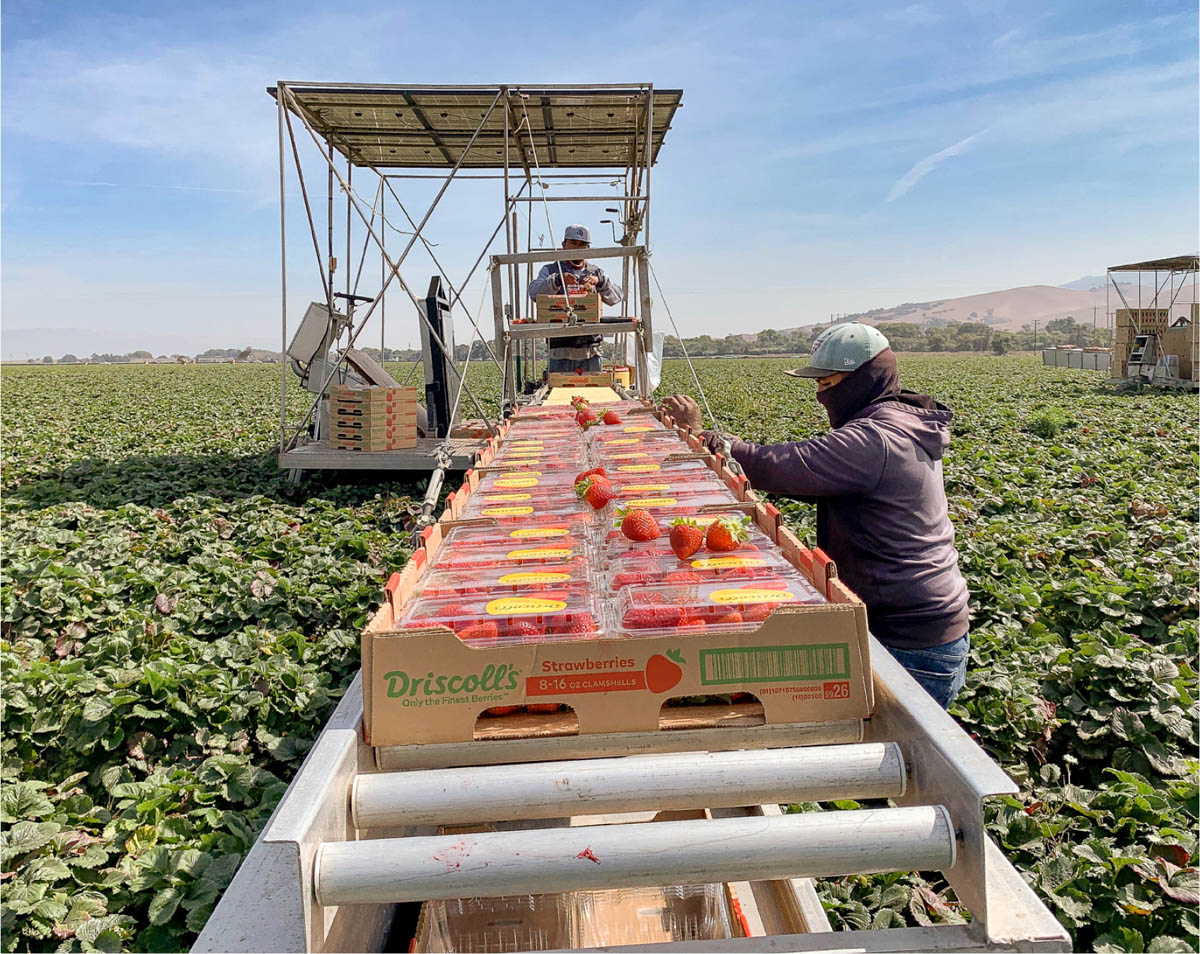All Issues
Proposed changes to the H-2A program would affect labor costs in the United States and California
Publication Information
California Agriculture 75(3):135-141. https://doi.org/10.3733/ca.2021a0020
Published online January 07, 2022
NALT Keywords
Abstract
The H-2A visa program allows farmers in the United States to be certified by the U.S. Department of Labor to recruit and employ guest workers, usually for a maximum of 10 months, when they are unable to find enough workers living in the United States (including U.S. citizens, other legally authorized workers, and workers not authorized to work in the United States). We analyzed U.S. and California H-2A job certification data to determine how the program is currently used and how a proposed H-2A wage freeze would likely affect future farm labor costs. Our analysis suggests that changes in the H-2A visa program would likely expand the program while reducing labor costs in California and elsewhere.
Full text
Since 1952, the H-2 (and, since 1986, the H-2A) visa programs have allowed farmers in the United States who anticipate a shortage of workers in the United States (U.S. citizens, other legally authorized workers, and workers who do not have U.S. government-issued work authorization credentials, hereafter referred to as undocumented workers) to fill seasonal farm jobs with workers from other countries (guest workers). Employers seeking to recruit and hire H-2A workers must first be certified by the Office of Foreign Labor Certification (OFLC) of the U.S. Department of Labor (DOL). The certification process requires that an employer satisfy three major criteria each year to hire seasonal guest workers: (1) try (and fail) to recruit U.S. workers, (2) offer free and approved housing to both H-2A workers and out-of-area U.S. workers and (3) pay an adverse effect wage rate (AEWR), which varies by state. (The AEWR for California was $14.77 an hour in 2020, 14% more than the state's $13 minimum wage.) Once employed, H-2A guest workers are tied to their employers by contracts and reside in the United States for an average of 6 months.
H-2A guest workers make up almost 3% of employment in California crop agriculture. In fiscal year 2020, California had 25,453 jobs certified to be filled with H-2A workers; 94% of those jobs were certified to crop or crop support employers. Photo: Danny Magno, Driscoll's.
The original H-2 program was created in the 1952 Immigration and Nationality Act as a means to recruit temporary workers in post-WW II America. During the 1950s, fewer than 10,000 agricultural jobs were filled by H-2 workers each year, predominantly in the Florida sugarcane industry. In contrast, the separate Bracero program — initiated in 1942 to recruit mostly Mexican guest workers — was much larger, peaking at 450,000 admissions a year in the mid-1950s. After the Bracero program ended in 1964, the DOL made it difficult for agricultural employers to switch seamlessly from Braceros to H-2 workers and, during the 1970s, H-2 certifications stayed low, confined primarily to the harvesting of sugarcane in Florida and apples in northeastern states (Martin 2009). The H-2 program was still relatively small in 1986 when the Immigration Reform and Control Act (IRCA) separated the program into two parts: H-2A for agricultural seasonal guest workers and H-2B for non-agricultural workers.
The IRCA included two legalization programs, including one for undocumented workers that granted legal status to 1.1 million individuals and imposed federal sanctions or fines on employers who knowingly hired undocumented workers. Many people expected legalized agricultural workers to move into higher-paying, nonagricultural jobs, and, as agricultural employers presumably sought to avoid fines for hiring undocumented workers, an upsurge in H-2A guest workers (Martin and Luce 1988). However, unauthorized migration of undocumented individuals increased in the 1990s, as some workers learned to provide false work-authorization credentials when hired. The IRCA did not require employers to determine the validity of worker documents, and the Immigration and Naturalization Service did not vigorously enforce the new employer sanctions law (Commission on Agricultural Workers 1992).
The H-2A program remained small in the 1990s because workers with false documents were readily available. After the Florida sugarcane harvest was mechanized in the mid-1990s, the locus of H-2A employment shifted from Florida sugarcane to North Carolina tobacco and to vegetable and apple farms in the Northeast (Martin 2009).
Since 2000, the H-2A program has quadrupled in size, and California has become one of the top five H-2A states (fig. 1). During fiscal year 2020 (FY20, from October 1, 2019, to September 30, 2020), California employers submitted 713 of the 13,549 applications submitted to the DOL's OFLC for H-2A certification. We analyzed all of these applications, as well as the 8,935 job offers that resulted from them, including 223 from California employers. (Some employers submitted several applications.) We found that California H-2A job offers promised each worker an average of $14,400 for approximately 26 weeks of work, more than the $12,500 average for 24 weeks of work by a U.S. worker (at an average wage of $13/hour). This examination of U.S. and California H-2A job offers provides a guide as to how the H-2A program would likely evolve under several proposed changes.
U.S. statistics and trends
The 2008–2009 recession slowed the entry of undocumented workers into the U.S. labor force. As a result, U.S. employers began to request more H-2A workers. The U.S. Immigration and Customs Enforcement (ICE) agency stepped up audits of the I-9 forms signed by newly hired guest workers and their U.S. employers (DOL OFLC 2021). ICE audits made employers aware of undocumented employees. In response, some employers formed associations to recruit and transport H-2A workers to their farms so that they would have employees with legal documents.
From 2010 to 2020, the number of certified H-2A jobs in the United States more than tripled, from 75,000 in FY10 to over 275,000 in FY20 (DOL OFLC 2021). Not all of the certified H-2A jobs are filled by such workers, and some H-2A visa holders are able to fill two or more certified jobs, as when an employer association moves a worker from one farm to another. In FY20, the number of H-2A visas issued was 213,000, 77% of the number of jobs certified (fig. 2).
FIG. 2. U.S. H-2A jobs certified and visas issued, FY05-FY20. Sources:DOL OFLC 2021; U.S. Department of State 2020.
Today, there are 1.5 million year-round or full-time equivalent (FTE) jobs in U.S. agriculture, including 1.1 million in crop cultivation and 400,000 in animal agriculture. California accounts for 425,000, almost a third, of these jobs, most of them (390,000, or 90%) in crop cultivation (BLS 2021). H-2A workers reside in the United States an average of 6 months, so two H-2A guest workers are equivalent to one full-time U.S. worker. H-2A workers thus account for almost 10% of average employment in U.S. crop agriculture and almost 3% of employment in California crop agriculture (BLS 2021; DOL OFLC 2021). California is one of six states that each had more than 10,000 H-2A jobs certified in FY20 (table 1). These six states collectively accounted for 55% of all U.S. H-2A certifications. Florida had 14% of H-2A jobs certified, Georgia and Washington had 10% each, California had 9%, North Carolina had 8% and Louisiana had 4%. H-2A workers play a much larger role in crop agriculture in southeastern states, such as Florida and Georgia, than in California and Washington, because more jobs are certified for H-2A workers and these states have less employment in crops.
All employers are exempt from paying federal unemployment insurance (UI) taxes on the wages of H-2A workers, and half of all states exempt H-2A workers from state UI taxes as well, including the states in the southeastern United States. California and Washington do not exempt H-2A wages from state UI taxes, so the Quarterly Census of Employment and Wages (QCEW) data approximate a census of agricultural employment and wages in these states.
The average number of H-2A jobs per certified U.S. application was 20 in FY20. The average duration of job offers or contracts was 168 days (24 weeks), and employers offered guest workers an average of 39.3 hours of work per week (943 total hours) (table 2). At an average U.S. AEWR wage of $13.29 an hour, a typical H-2A contract during FY20 was thus worth $12,711, and the total H-2A wage bill for the country was $3.5 billion. Almost half of this total wage bill was paid in the top five H-2A states (fig. 1): Florida ($395 million), Washington ($386 million), California ($375 million), North Carolina ($275 million) and Georgia ($228 million).
The value of H-2A job offers and thus H-2A wage bills by state are approximate for several reasons. First, only 80% of certified job orders result in the issuance of H-2A visas. Second, workers could earn less than 100% of the contract value if a job finishes early. (Employers must satisfy the three-fourths guarantee in these cases, meaning that they must guarantee at least three-fourths of the pay specified in a job offer.) On the other hand, workers could earn more than 100% of a contract's value if they work more hours than promised, if they work under piece-rate wage systems and earn more than the AEWR or if they earn overtime wages and bonuses. There are no data on H-2A worker earnings, but analysis of payroll data from some employers suggests that our estimates are a lower bound since most H-2A contracts offer less than 40 hours of work a week and many H-2A workers are employed more than 50 hours.
Florida had the most jobs certified to be filled with H-2A workers in FY20, an average of 67 per application. Florida's average contract length was 23 weeks with an average of 37 hours per week, so that the average contract was worth $10,119 at the state's AEWR of $11.71. In California, the number of jobs per certified application averaged 36 in 2020. The average duration of California H-2A contracts was 183 days, or 26 weeks, and the average hours offered per week was 38; thus, an H-2A worker who was paid the state's AEWR of $14.77 an hour would have earned $14,738. In FY20, California had three of the 10 largest H-2A employers in the United States, and all were farm labor contractors (FLCs), including two that operated in both California and Arizona (table 3). (The largest California H-2A employer, Fresh Harvest, is based in Imperial County but also has operations in Yuma, Arizona.) California's three largest H-2A employers accounted for a third of all H-2A jobs in the state in FY20 and offered contracts whose value ranged from $8,700 to $16,300, putting California FLC contracts near the low and high ends of the spectrum among the top H-2A employers.
California statistics and trends
Although California is today one of the top users of the H-2A program, California farmers have been reluctant to use it for several reasons (Martin 1994). First, some employers feared that union supporters might respond to the job offers they were required to make to U.S. workers in order to be certified, potentially opening the door to a union election and bargaining obligation. Second, some employers objected to paying an AEWR that exceeded the state's minimum wage and did not have the free housing that must be offered to H-2A workers. Third, because all H-2A employers are required to make their job offers public, some employers feared that they would become the targets of investigations by labor law enforcement agencies, who could quickly compare employer promises to actual wages and working conditions.
In FY20, California had 25,453 jobs certified to be filled with H-2A workers, including 24,015 jobs, or 94%, certified to crop or crop support employers. Nine counties in California each had more than 1,000 certified H-2A jobs (fig. 3), but the distribution of H-2A certifications by county differed from the distribution of agricultural employment by county. The top five California counties for H-2A jobs — Monterey, Santa Barbara, San Luis Obispo, Ventura and Fresno — accounted for 55% of the H-2A certified jobs, even though these five counties accounted for only 38% of the state's crop and crop support employment. Monterey County was California's leading H-2A employer in FY20, with 6,394 certified jobs, followed by Santa Barbara County with 2,668 certified jobs, and San Luis Obispo, Ventura and Fresno counties, each with more than 1,500 certified jobs.
FIG. 3. California H-2A job certifications by worksite county (FY20). Source: FY20 OFLC disclosure data.
Most California H-2A jobs in FY20 were with crop and crop support employers (NAICS 111 and 1151). In Monterey County, 6,155, or 96%, of the H-2A jobs were with crop and crop support employers. These contracts offered an average of 222 days of work, which means that H-2A workers filled 3,748 FTE jobs, or 7% of average crop and crop support employment. The 2,513 H-2A crop and crop support jobs certified in Santa Barbara County offered an average 209 days and comprised 1,438 FTE jobs, or 6%, of the county's average crop and crop support employment. San Luis Obispo County contracts averaged 239 days, so the 1,774 crop and crop support jobs represented 1,164 FTE jobs, or 25%, of county crop and crop support employment. Ventura County had 1,667 jobs, with an average length of 127 days representing 578 FTE jobs, or 2%, of county crop and crop support employment. Fresno County had 1,457 jobs, with an average duration of 104 days and represented 414 FTE jobs, or 1% of county crop and crop support employment.
H-2A jobs are concentrated in coastal counties that tend to have high wages and high housing costs. Half of California agricultural employment is in the San Joaquin Valley, where there have been relatively few H-2A job certifications because U.S. workers are available.
Proposed H-2A changes
The H-2A program is an efficient mechanism to obtain just-in-time guest workers who are tied to employers by contracts, providing labor insurance to producers of perishable commodities at the cost of paying for worker housing and transportation of perishable commodities. There have been many efforts to modify the program, and on July 26, 2019, the DOL's OFLC proposed major changes. Among them was a shift from the current practice of setting one AEWR per state to setting separate AEWRs for each occupation or job title. The OFLC proposed to use earnings data from the U.S. Department of Agriculture's (USDA) Farm Labor Survey (FLS) to set AEWRs for most farm jobs. However, they proposed the use of the DOL's Occupational Wage and Employment Statistics (OWES) program to set AEWRs for farm-related jobs, such as those in construction and transportation, for example, for workers who build farm structures and haul commodities.
On September 30, 2020, before the DOL issued final regulations to implement these proposed changes, the USDA cancelled the FLS. However, a federal judge intervened and ordered the USDA to resume the program and collect the farmworker earnings data used by the DOL to set AEWRs. Meanwhile, on November 5, 2020, the DOL published a final regulation that froze AEWRs for 2021 and 2022 at their 2020 levels and ended reliance on the FLS to adjust these AEWRs in the future. The same federal judge who ordered the USDA to resume the FLS program earlier in the year blocked the DOL from implementing this final regulation, which was withdrawn by the Biden Administration on January 20, 2021.
From 2010 to 2020, the number of certified H-2A jobs in the United States more than tripled, from 75,000 to over 275,000. A proposal to freeze the adverse effect wage rate could speed the growth of the H-2A visa guest worker program even further. Photo: Danny Magno, Driscoll's.
The new AEWRs for 2021 rose an average 4.3% across the United States and 8.7% in California, bringing California's AEWR to $16.05 an hour, 15% above the state's $14 minimum wage. Rising AEWRs have not slowed California or any U.S. employer requests for H-2A workers. The number of U.S. farm jobs certified to be filled by H-2A guest workers in FY21 continues to increase, likely topping 300,000 for the first time (Rural Migration News Blog 2021b).
In March 2021, the U.S. House of Representatives approved the bipartisan Farm Workforce Modernization Act (FWMA, or HR 1603) on a 247-174 vote. The FWMA would turn many of the DOL's July 2019 AEWR proposals into law, including setting AEWRs by job title, freezing AEWRs and limiting annual increases in AEWRs. (The FWMA is included in the more-comprehensive U.S. Citizenship Act [USCA] of 2021, which would provide an 8-year path to U.S. citizenship for 11 million undocumented workers. The USCA also includes the American Dream and Promise Act [HR 6], which provides citizenship for children who arrived in the United States before age 16.)
The FWMA, which can be enacted separately, has three titles, one for legalization, one for H-2A streamlining and one for verification. Title 1 would allow undocumented farmworkers to become certified agricultural workers (CAWs) if they performed at least 180 days of farm work over the previous two years. CAW status would be extended indefinitely for those who do at least 100 days of farm work a year. The spouses and minor children of CAW status holders would also receive work and residence visas and would not have to do farm work to maintain their status (Rural Migration News Blog 2021a). CAW workers who have performed at least 10 years of agricultural work in the United States could become permanent or legal immigrants if they perform at least 100 days of farm work for four additional years, while those who have performed fewer than 10 years of agricultural work in the United States would have to do eight more years of farm work to become permanent or legal immigrants.
Title 2 would streamline the H-2A program in four ways: (1) make the application process and job ads electronic, (2) introduce 3-year visas, (3) allow 20,000 H-2A workers a year to be admitted for employment in year-round dairy and other farm jobs and (4) add funding to build housing in agricultural areas. AEWRs would be set by job title and frozen for a year, after which increases would be capped at 3.25% a year for the next 9 years. A Portable Agricultural Worker (PAW) pilot program would allow up to 10,000 farm guest workers to be free agents in the U.S. farm labor market for 3 years. PAW visa holders could only work for farm employers, and they would maintain their legal status by not being unemployed more than 60 days a year; their freedom to change employers would presumably protect PAWS from exploitative employers.
Finally, Title 3 would require all farm employers to use electronic verification (a program called E-Verify) once the legalization and H-2A streamlining changes are implemented. In addition, if the FWMA is enacted, USDA and DOL would be required to study whether the employment of H-2A workers has depressed the wages of U.S. farmworkers, whether the AEWR is necessary to protect the wages of U.S. farmworkers and whether any changes are warranted in the methodologies used to calculate AEWRs.
AEWRs rose by an average 4% a year between 2010 and 2020. Freezing the estimated $3.5 billion wage bill of H-2A workers in 2020 would save employers of H-2A workers $140 million a year. Farms that employ H-2A workers also employ an estimated 50,379 U.S. workers in corresponding employment alongside H-2A workers, and their wages would also be frozen, saving H-2A employers an additional $29 million and making the total savings of an AEWR wage freeze at least $169 million a year (table 4).
The savings from an AEWR wage freeze could be larger if employers request more H-2A workers as a result of stable wages or if an AEWR freeze slows the growth in wages of the non-H-2A workers who fill 90% of the jobs in U.S. crop agriculture. The number of H-2A jobs has been increasing despite the rising AEWR, so a stable AEWR could accelerate H-2A expansion. The links between AEWRs and the wages of U.S. workers are uncertain, but a frozen AEWR could reduce the growth in the U.S. wage bill, which in 2020 was $21.6 billion for crop farms and $12.1 billion for crop support services — a total of $33 billion.
H-2A expansion in California
While the number of U.S. jobs certified to be filled by H-2A workers has tripled over the past decade, the number of H-2A jobs rose even faster in California. Several factors have influenced this increase in H-2A employment in California, notably the expansion of labor-intensive agriculture and a decrease in unauthorized migration (mainly due to tighter border control and improved conditions in Mexico). The proposal to freeze the AEWR could speed the growth of the H-2A visa guest worker program even further and return California to a 1950s-style farm labor market, when California had the most Mexican Braceros of any state (Rural Migration News Blog 2020a).
There are several differences between 1950s Braceros and 21st century H-2A workers. First, employer associations recruited and employed many of the Braceros, while the leading employers of H-2A workers today are FLCs. Second, most Braceros worked cotton, sugar beets and other field crops through the mid-1950s, while most H-2A workers today are employed in fruit and vegetable crops. Third, most Braceros lived in employer-operated camps on farms, while many H-2A workers are housed in urban motels where the furniture is replaced by bunk beds.
Several factors will influence the expansion of H-2A employment in California agriculture. Rising labor costs encourage labor-saving mechanization even as rising consumer demand for fresh berries and other commodities increases the employment of hand workers until machines are perfected. Meanwhile, increased imports are narrowing windows of profitable production for some fresh fruits and vegetables, increasing incentives for California growers to save on rising labor costs (Rural Migration News Blog 2020b).













